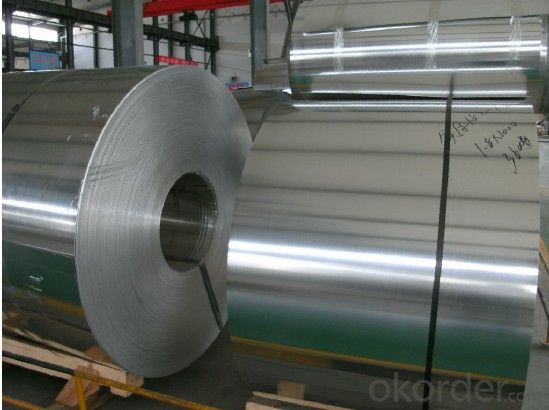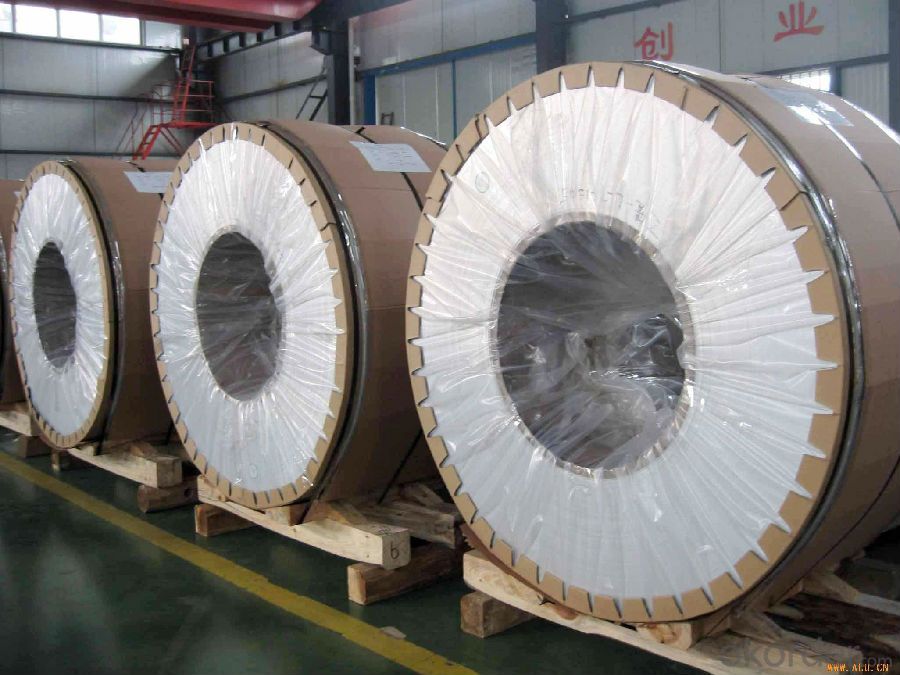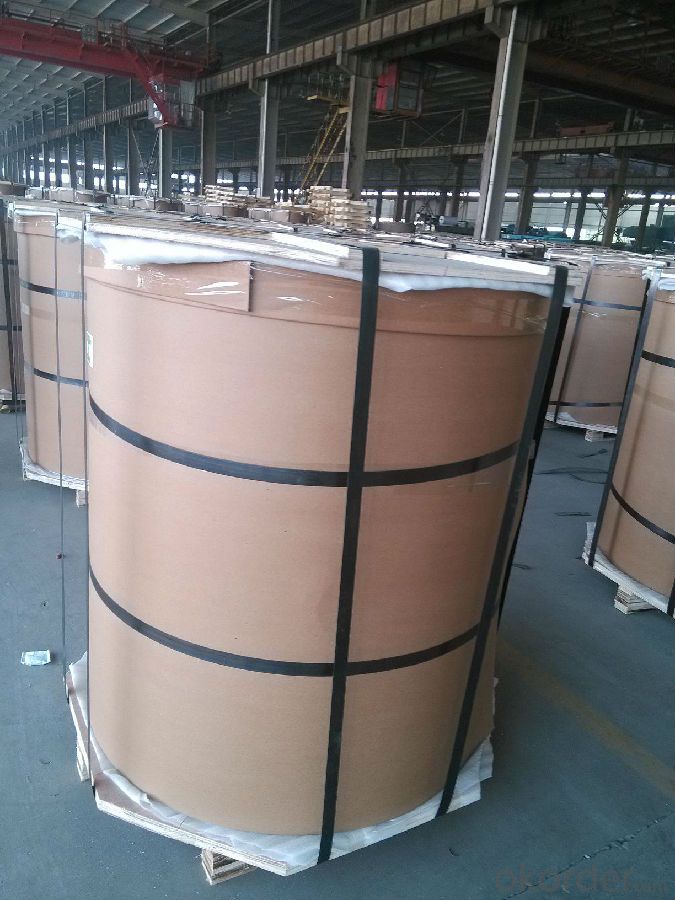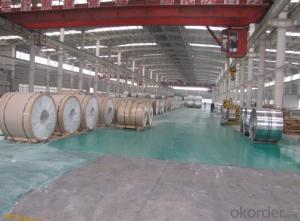Direct Casting Aluminium Coils for Deep Drawing
- Loading Port:
- Shanghai
- Payment Terms:
- TT OR LC
- Min Order Qty:
- 5 m.t.
- Supply Capability:
- 20000 m.t./month
OKorder Service Pledge
OKorder Financial Service
You Might Also Like
Item specifice
1.Structure of DC Aluminium Coils for Deep Drawing
DC Aluminium Coils for Deep Drawing is one semi-finished aluminium material. This strip can be rolled down to aluminium coil,sheet,circle ect. The alloy AA1050 is widly used in building, industry ect. Its weight is much lower than steel. So many customers choosed aluminium material instead of steel.
2. Main features of DC Aluminium Coils for Deep Drawing
a.Competitive price---We have our own mills and can produce mill finished aluminium coils, so we can control the production cost better.
b.Professional after-sale service---We have more than 15 years exportation experience and you need not worry about the exporation problems.
c.Fast delivery time---We can control the delivery time within 35 days.
3. Image



4. Product Specification
| Alloy | Temper | Style | Thickness | Width |
| AA1100 | H14 | Direct Casting | 0.2mm-3mm | 1000mm-1500mm |
5.FAQ:
What is the quality standard?
---Usually our standard is GB3880-2006
What is the largest width?
---It is 2300mm
What is the MOQ?
---Usually we can accept 80 tons.
- Q:I'm working on a costume that's entirely made of cardboard (it's a giant robot), and I was wondering What's the best way to1 turn Soda cans into aluminum sheeting2: attach the aluminum everywhere on the robot3. Attach the aluminum to the aluminumThank you in advance.
- You are going to hate this answer: because the answer is: It depends. Without further details of what you are trying to accomplish its hard to know. 1: For instance if you are just trying to get small sheets of aluminum...cut off the top and bottom with scissors and one straight line down the middle. But if you are looking for something more accurate you may need to use a press or just buy sheets 2: Again, without knowing details its hard to say...perhaps you should use ducktap and layer the aluminium onto the cardboard like scale armor 3: you could use glue I guess....or do a weak weld...or if you scaled the aluminum then you wouldn't ahve to connect the aluminum to itself only to the cardboard. But it all depends on how quality you want the project to look...and what you want the end product to look like. But since you are talking about cardboard and cans I'm guessing scaling the aluminum with duck tape should work for you.
- Q:Could you tell me the difference between the 6063 aluminum plate and the 5052 aluminum plate?
- 6063 and 5052 alike: aluminum alloys with Mg Mg as the main alloying element
- Q:What are the different types of alloys used for aluminum sheets?
- There are various types of alloys used for aluminum sheets, including 1xxx, 3xxx, 5xxx, and 6xxx series. Each alloy has unique properties and characteristics, making them suitable for different applications. The 1xxx series alloys are pure aluminum, while the 3xxx series alloys contain manganese and exhibit good formability. The 5xxx series alloys have magnesium as the primary alloying element and offer excellent corrosion resistance. Lastly, the 6xxx series alloys are known for their combination of strength, formability, and weldability, with magnesium and silicon as their main alloying elements.
- Q:how to distinguish the physical property of copper sheet from the one of aluminum sheet?
- physical property: copper sheet: golden, heavy, aluminum sheet: white, light.
- Q:What are the different forming techniques for aluminum sheets?
- Aluminum sheets can be shaped using several different forming techniques. One technique commonly used is bending, where force is applied to the sheet to achieve the desired shape. This can be done manually with a press brake or through automated processes like roll forming or stretch forming. Another technique, called deep drawing, involves using a die and punch to stretch the aluminum sheet into a three-dimensional shape. This method is often employed to create cylindrical or box-shaped components such as cans or containers. Hydroforming is another option for shaping aluminum sheets. It utilizes hydraulic pressure to mold the sheet against a form or mold. This technique is particularly useful for creating complex and irregular shapes that would be challenging to achieve with other methods. For creating symmetrical shapes like bowls or cones, spinning is a commonly used technique. It entails rotating the aluminum sheet against a mandrel while applying pressure to shape it into the desired form. Lastly, there is a technique known as stamping, which involves pressing the aluminum sheet against a die to create a specific shape. This technique is frequently employed in high-volume production of components such as automotive body panels. In conclusion, these forming techniques provide a wide range of options for shaping aluminum sheets into various forms and designs. This allows for flexibility and versatility in manufacturing processes.
- Q:Are aluminum sheets suitable for use in marine or saltwater environments?
- Yes, aluminum sheets are suitable for use in marine or saltwater environments. Aluminum has excellent corrosion resistance properties and is known for its ability to withstand the harsh conditions found in marine environments. Unlike many other metals, aluminum forms a protective oxide layer on its surface when exposed to oxygen, which helps prevent further corrosion. This oxide layer acts as a barrier, protecting the underlying metal from saltwater and other corrosive elements. Additionally, aluminum is lightweight yet strong, making it an ideal choice for marine applications where weight reduction is important. It is commonly used in the construction of boats, ships, offshore structures, and other marine equipment.
- Q:How do you ensure the flatness of an aluminum sheet?
- To ensure the flatness of an aluminum sheet, several steps can be followed: 1. Material selection: Start by selecting aluminum sheets that have a high degree of flatness. This can be achieved by choosing sheets with a uniform thickness and minimal surface imperfections. 2. Storage and handling: Store the aluminum sheets in a flat and stable position to prevent any warping or bending. Avoid stacking heavy objects on top of the sheets, as this can lead to deformation. When handling the sheets, use proper lifting techniques and support them evenly to maintain their flatness. 3. Surface preparation: Before using the aluminum sheet, ensure that the surface is clean and free from any dirt, dust, or debris. Any foreign particles on the surface can cause unevenness or imperfections. 4. Use of leveling equipment: For larger aluminum sheets or those with high flatness requirements, leveling equipment can be used. This equipment includes hydraulic or mechanical straightening machines that apply pressure to the sheet, correcting any deviations and ensuring a flat surface. 5. Heat treatment: In some cases, heat treatment can be performed to relieve any residual stresses within the aluminum sheet. This process involves heating the sheet to a specific temperature and then cooling it slowly to reduce any internal strains that might affect its flatness. 6. Quality control: Implementing a rigorous quality control process is essential to ensure the flatness of aluminum sheets. This involves inspecting each sheet visually and using specialized measuring tools such as straightedges, calipers, or laser measurement devices to check for any deviations from the desired flatness. By following these steps, manufacturers and users can ensure the flatness of aluminum sheets, which is crucial for applications where precision and accuracy are required, such as in the manufacturing of electronic components, aerospace industry, automotive parts, and architectural applications.
- Q:I'm about to fix the aluminum wiring in my house using Alumiconn connection, so I know that every outlet and switch plate need to be done, do the light fixtures need to be done as well? And also does anything need to be done with the main circuit breaker?
- Anywhere you have a tap the new method should be done. The kitchen outlets that draw more amps usually have the biggest problem but with vacuum cleaners that draw about 10 or 12 amps all outlets are a problem. The wires should be taken off all outlets and tapped to a short copper wire with approved method and the the copper wire is put to the outlets and also switches. All taps have to use the right type of paste and right crimps and or wire nuts. The main breaker if alum wire should be taken off wire brushed and have the right type of Penetrox paste put on wires and put back. If the breaker can fit one of those crimp ends you put on alum wire and insert in breaker better yet. I did one house years ago and it is a job. I was able to fish new copper wire to all the kitchen outlets all the way back to panel.
- Q:What are the different methods of joining aluminum sheet?
- Some of the different methods of joining aluminum sheet include welding, adhesive bonding, riveting, clinching, and mechanical fastening.
- Q:Can aluminum sheets be anodized with custom designs?
- Yes, aluminum sheets can be anodized with custom designs. Anodizing is a process that creates a protective oxide layer on the surface of aluminum, and this layer can be dyed or printed with custom designs before sealing, allowing for personalized and decorative finishes on aluminum sheets.
1. Manufacturer Overview |
|
|---|---|
| Location | |
| Year Established | |
| Annual Output Value | |
| Main Markets | |
| Company Certifications | |
2. Manufacturer Certificates |
|
|---|---|
| a) Certification Name | |
| Range | |
| Reference | |
| Validity Period | |
3. Manufacturer Capability |
|
|---|---|
| a)Trade Capacity | |
| Nearest Port | |
| Export Percentage | |
| No.of Employees in Trade Department | |
| Language Spoken: | |
| b)Factory Information | |
| Factory Size: | |
| No. of Production Lines | |
| Contract Manufacturing | |
| Product Price Range | |
Send your message to us
Direct Casting Aluminium Coils for Deep Drawing
- Loading Port:
- Shanghai
- Payment Terms:
- TT OR LC
- Min Order Qty:
- 5 m.t.
- Supply Capability:
- 20000 m.t./month
OKorder Service Pledge
OKorder Financial Service
Similar products
New products
Hot products
Related keywords





























